This is not a review of Baldur’s Gate 3.
The game has been reviewed (massively so!), received almost every honor the gaming industry can award, and has been out for several months (after a playtest of many years). This makes it ideal for my series of unimportant reviews.
However, I’m doing something else: I’m documenting why I like this game so much, followed by a “diary” of my experiences within the game.
I’ve run through the game six times so far (nowhere near a record!), and have just started a seventh. In this essay, I’m going to try to articulate why.
It’s another super-long post. As with my epic one on 3D printing, that’s largely because of the number of photos and YouTube previews.
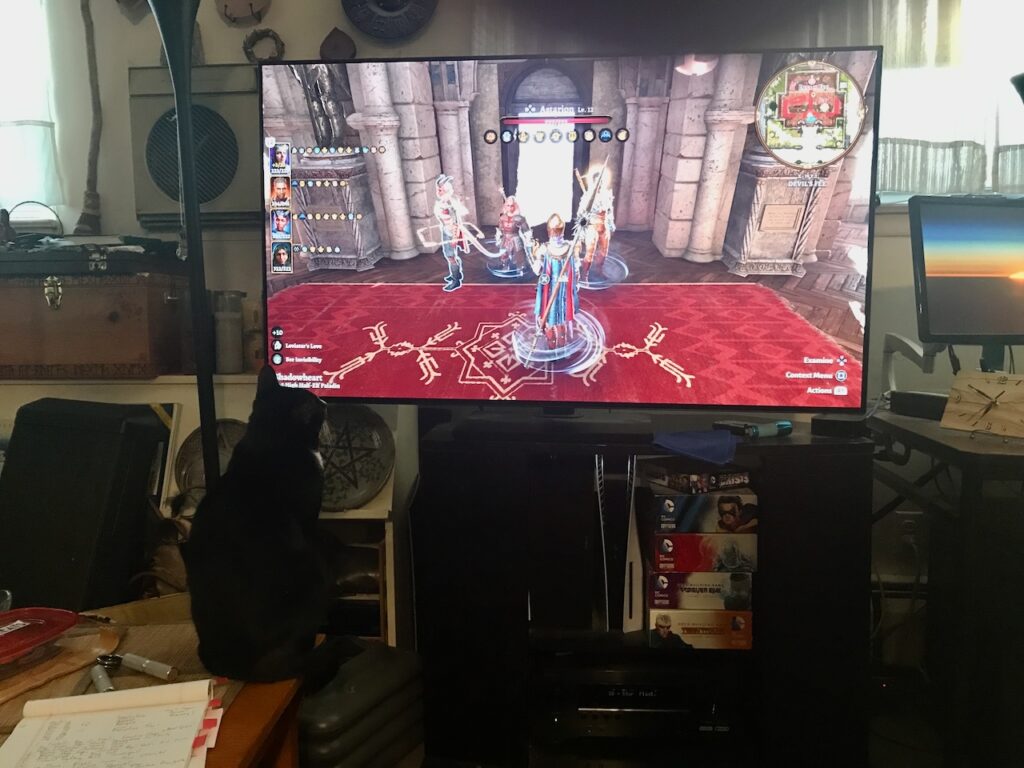
System
I hate the D&D system.
I started playing D&D in 1975, and understood that I hated it in 1978.
My feelings about the system haven’t changed. It’s 2024. That’s 46 years of hate (so far).
That’s a lot of hate.
I’ve played D&D both in-person and on-line periodically throughout the years. I’ve played for the story and camaraderie, but not for the system. I typically don’t bother to learn much about the system’s details at all. In every D&D game I’ve played (since 1978), there have always been people who were willing to help me; I’d say “I want to attack the Orc” and they’d tell me which dice to roll.
BG3‘s game system is based on D&D5e (the fifth edition of the Dungeons & Dragons rules). I’ll go so far to say that no game I’ve ever seen has duplicated the D&D5e system so faithfully (not that I’ve sought out D&D-based computer games).
Clearly, I don’t love BG3 because of its game system, but in spite of it.
What has generally made the game’s system tolerable for me is that (with one exception) I play on the game’s easiest difficulty level, “Explorer”.
I also take advantage of the myriad of build guides available both as web pages and YouTube videos. Many of them are based on successful builds in D&D, which usually work just as well in BG3: e.g., Sorcadin (part Sorcerer, part Paladin); Throwzerker (a Berzerker Barbarian specializing in thrown weapons); Monkassin (part Monk, part Rogue Assassin).
Not all of these resources are of the same quality. I’ve learned that some sites are useless, with content that looks like it’s been generated by AI, or over-enthusiastic videos with titles like “Most OP Build Ever!”
If you want to do the same thing, one way to tell if a build guide is worth anything, at least to folks like me:
- Check if the start of its suggested equipment includes items whose name begins with “Helldusk”. The Helldusk items are only available near the end of the game, unless one plays in a bizarre fashion, which has problems of its own. There are other end-game items than the ones that start with “Helldusk”, but at this point in this essay I don’t want to spoil too much.
-
See if they’re intended for “solo Honor mode”; in other words, playing with a single character (normal party size is four) on the highest difficulty level the game offers. Such builds are written by and for experienced BG3 players. They usually rely on one character getting the most useful item combinations.
For example, only one party member can wear both the Callous Glow Ring and the Coruscation Ring. If you’re running a four-character party (as I always do) these “OP” video suggestions will create conflicts with other optimized characters I might want in the same party.
- Others are only concerned with the character once they reach level 12 (the highest allowed in the game) and are unconcerned with the struggle to reach that level.
Once I winnowed the guides to a useful sample (note that my YouTube playlist contains videos that turned out not to be useful), I found plenty that suited my low skill level, yet introduced interesting gameplay within BG3‘s version of the D&D5e system. I liberally insert the videos in my diary below.
My playlist of BG3-related videos:
I know that an experienced gamer might not think much of my pleasure at watching enemies evaporate in the face of Lae’zel built as a Open Hand Monk in Explorer difficulty. So be it. This is my sandbox, and I’ll play as I choose.
The game’s publisher, Larian Studios, has stated that BG3 will be the only game in the “D&D universe” that they’ll publish. If a Baldur’s Gate 4 is ever released, it won’t come from them.
For my part, unless this hypothetical BG4 can match Larian’s skill in design and storytelling, I won’t be interested. On the other hand, I’m very much looking forward to whatever game Larian releases next, though I know it will be many years before that happens.
Music
I’m sure there are plenty of music snobs who feel that video-game music isn’t “real” music.
They may not understand how hard the task is. Game players may hear various themes played over and over again. For a large game like BG3, with over a hundred hours of game-time in a single playthrough, they may listen to the same themes played more often than a music critic will hear Beethoven pieces over their entire lifetime.
Music for a game like BG3 has to be carefully crafted: special pieces for the key story moments in the game, repeating background music for general tasks like exploration, exciting themes for combats. It all has to blend to a unified whole.
BG3 achieves this. Its music was composed by Borislav Slavov. The game is not only notable for his instrumental scenic music, but for the vocal compositions scattered throughout the game.
My favorites are:
-
“Down by the River” – This song plays as you create your character.
The first time I heard it, I knew I entered into a unique game experience. I wonder how many people go through multiple playthroughs just to listen to this song again.
-
“I Want to Live” – I first heard this song on the BG3 soundtrack. It only plays during the game if you stand on a specific spot at two of the game’s campsites. I can’t tell you the number of times I’ve moved my character to one of those sites and just listened to the song.
The song is supposed to reflect the experience of the character Astarion. When I first heard it, I associated it with Karlach. In a way, it can refer to any of the “Origin” characters, but I acknowledge that it fits most closely with Astarion.
-
The title of my favorite song may be a spoiler, so I won’t mention it here. I’ll only say that you’ll have a devil of a time listening to it.
I’ll admit I’ve enabled the encounter that causes this song to play solely to hear it again within the game, even when I didn’t need to.
-
I’ll give special mention to “The Power”, which plays over the game’s end credits.
Most gamers tend to skip the credits in favor of any post-credit scenes (and BG3 does not disappoint here). It wasn’t until my fifth playthrough that I finally really listened to it.
- Every playthrough (as I’ll document below) has revealed something new about the game. I didn’t hear “The Weeping Dawn” until my sixth playthrough. I look forward to listening to it again in my seventh.
Characters
The main characters in BG3 can be loosely grouped into categories.
Tav
The first category is a character you can create from scratch, with whatever stats and abilities that are permitted by the D&D system. Such a character is given the default name of Tav before you change it. If you see someone describe a character as a “Tav”, that means they designed the character on their own.
A Tav doesn’t have an individual story. They can experience the other character’s stories, and there are dialog options that will only appear for certain classes or races. But there’ll be no adventure specifically crafted for you if you play, for example, an Elf Barbarian versus a Gnome Cleric.
While the system for character abilities is firmly rooted in D&D, the system for character appearance is most free-form that I’ve ever seen in a game. It has the usual general options (skin tone, hair, eyes, etc.), and there are suboptions that open the door for acceptance for real-world marginalized groups. I was pleased to see that you can set your character’s vitiligo percentage as easily as you can set their tattoo design or scar pattern.
What really tilts the acceptance meter, to the point where I think the game is going to win all the Gayming Awards, is their handling of gender, genitals, and body shape. Many gamers are stunned when they create a character for the first time, and see a nude image of your character and are given the choice of which genitals they have. This choice is completely independent of the character’s voice (which you can select) or general body type (male, female, androgynous).
While none of the Origin characters are trans, some of the hirelings you can pay to accompany you are. There’s also a trans character with a speaking role, whom you might meet late in the game.
I can think of no other game of this type that has reached so far in representation and acceptance.

Origin
So far, I’ve only played a Tav once. My other playthroughs have been with Origin characters.
As you play the game, it’s likely you will encounter these Origin characters, even if you don’t play one. They come with their own story, dialog, cutscenes, special encounters, personality, goals, hopes, and destinies.
You don’t have to include them in your party, After a certain point, you can recruit hirelings who have no story (and no personality). You won’t want to do that, unless you’re doing one of those “Power-Honor” runs I described earlier. It’s the Origin characters that make the game.
Whether you play a Tav, or play as one of the Origin characters, you get to choose how the other characters’ stories play out. You can encourage them on a positive path, a destructive path, or simply not to interact with them at all.
Another good reason to play an Origin character is that they come pre-designed, with attributes and abilities appropriate to that character. This gives a quick “let’s play” option for those unfamiliar with the D&D system.
From a game standpoint, the characters’ stats are not optimized for their roles. However, a short while into the game, you have the option of “re-speccing” any of the characters in your group. You can improve their game stats to make them better at their assigned roles (it’s not hard to make Karlach a better Barbarian) or give them a completely different character class (you can make Karlach a Bard, if you wish).
With one exception (which I’ll spoil in the diaries below), Larian worked to make each of these characters fully engaging throughout the game. If you play as an Origin character, you can follow the story assigned to that character, ignore that story, or explore alternatives that are not available unless you play as that character (see my second playthrough in the diary).
Part of the reason for why the characters are so engaging is the excellent voice work. All of the voice actors associated with BG3 have received renewed and well-deserved attention since the game’s release.
I’ve watched some of the videos posted by Samantha Béart, who supplies the voice of Karlach. She explains that the BG3 voice actors recorded motion capture for their faces, perhaps as far down as their shoulders. But the overall characters’ motion capture, appearance, and of course spoken lines came from a team of creators. In her words, “It takes a village to make a Karlach.”
There’s another aspect to the Origin characters that’s received considerable attention: Your character (whether a Tav or another Origin character) can attempt to enter into a romantic relationship with them.
This is not unique in video game history. In the Mass Effect series, for example, your character (Commander Shepard) can romance many of the characters in the game.
What makes BG3 different in this regard:
- In ME, it’s always Commander Shepard who’s instigating the romance. in BG3, any character you play can attempt to romance any of the Origin characters (and one or two more besides).
- There are sex scenes in BG3. Unlike ME and other games with such scenes, each one is crafted to suit the character being romanced. These scenes range widely in explicitness, as befits the personalities of the characters.
- The sex scenes are not the culmination of the romance. The characters’ relationship continue, and you have some choices about how it evolves. Some characters will accept if you have sex with a devil, others will dump you on the spot. You can also break off a relationship if you tire of it.
- The romancable (or sexable) characters have no gender preference. In ME, some characters would not let themselves be romanced if were playing a Commander Shepard of a given gender. In BG3, they’ll sleep with you no matter who are… provided you can earn their approval. That’s based on your actions, not on your appearance.
- According to Samantha Béart, there was an intimacy coordinator available as she recorded her lines for the romantic scenes, even though she was alone in her room during the recording and she was only being recorded from the neck up. As a player, I think this shows in the honesty of the emotions expressed during these scenes.
-
It’s not just sex. Once a romance is established, you can ask your partner to kiss you. In a recent game patch, Larian went all out to animate the kissing scenes. There are variations between characters, adjustments for character height, and intensity of kisses. Your partner’s reaction to each kiss varies as well.
The kisses are more romantic than the sex scenes.
BG3 has been described as a dating sim with a lot of side quests. I can present no evidence to contradict that description.
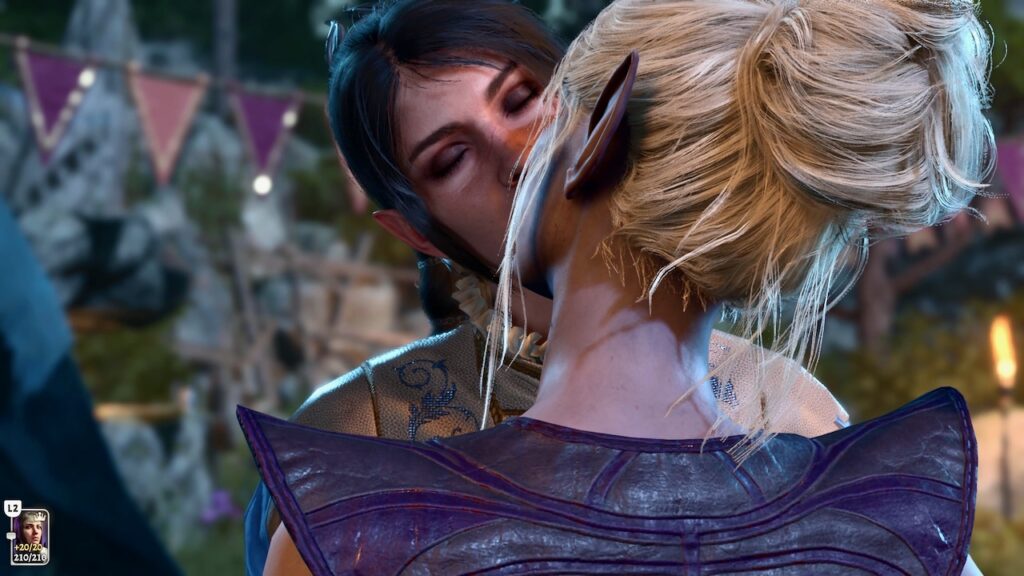
The Dark Urge
There’s one other type of character. They’re like an Origin character, in that they have their own story that evolves throughout the game. They’re also like a Tav, in that you can craft their stats and appearance.
All of the Origin characters have brief introductions you can watch before you choose which one to play. In the case of The Dark Urge, the intro makes it clear: this character has an almost uncontrollable urge to murder.
While a Tav can act like an evil character, The Dark Urge is specifically designed for those players who want to have a story that supports and embraces an Evil playthrough.
Just because you’re playing a character with an impulse to murder doesn’t mean you have to give in to the urges. You still have the choice to go on the hard path of redemption for your past crimes.
The general wisdom is that The Dark Urge should not be your choice for your first playthrough. I agree with this. Without knowing the story and the consequences of your actions, you might turn into a simple “murder hobo” (someone who kills every game character they meet), which would make the game incredibly difficult.
For experienced players, there’s another reason to play The Dark Urge: It has access to a unique magic item. Players who are more interested in gameplay than story might pick The Dark Urge automatically just for the item, and simply skip over any Evil story elements.
Story
Before BG3, Larian Studios’ previous game was Divinity Original Sin 2, a game similar in style and scope to BG3. When I skim the videos that compare the two, the impression I get is:
- The game system used in DOS2 is better than BG3. (No surprise to me, given my antipathy towards D&D).
- The story of BG3 is better than that of DOS2.
The hard-core gamers tend to rate DOS2 higher. It’s all about the system to them.
For me, it’s all about the story. After glancing at the DOS2 materials, I don’t feel much incentive to play that game. I have no idea where I’ll go after my honeymoon with BG3 is over, but it won’t be there.
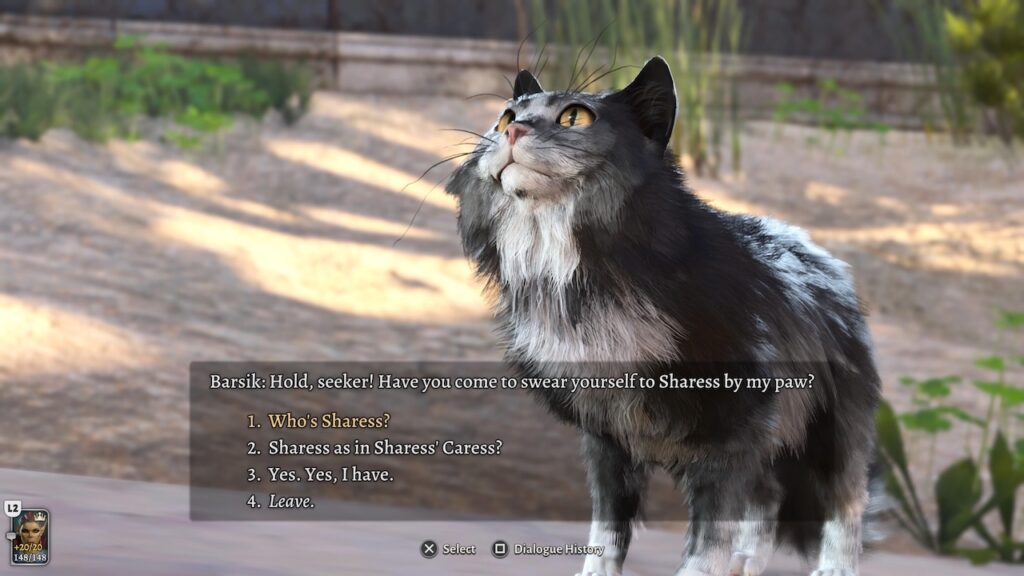
Stories with branching storylines and multiple outcomes are nothing new in the gaming industry. Larian claims there are roughly 17,000 possible endings in BG3, a claim that’s probably true but overblown.
What makes BG3‘s story special?
The most obvious reason is the quality of the writing. I mentioned above how video-game music may be listened to over-and-over during the course of the game. The story of BG3 seems crafted to be experienced over and over.
The game’s story has three major Acts. The big story beats near the end of each Act will be similar for each playthrough. But the journey to each beat is up to the player. The player’s choices will impact what will happen at the end of each Act, what allies and resources you’ll have available afterwards, and will affect the characters’ opinions of you.
Each Origin character’s story has its own beats. As I noted above, you can influence how that story goes. You can even behave so poorly (from the perspective of the non-player character) that they leave you, or even attack you.
The characters are so well-written that I find myself caring about what happens to them. That doesn’t mean I try to please every character on every playthrough, but it does give me the sense that my game choices matter.
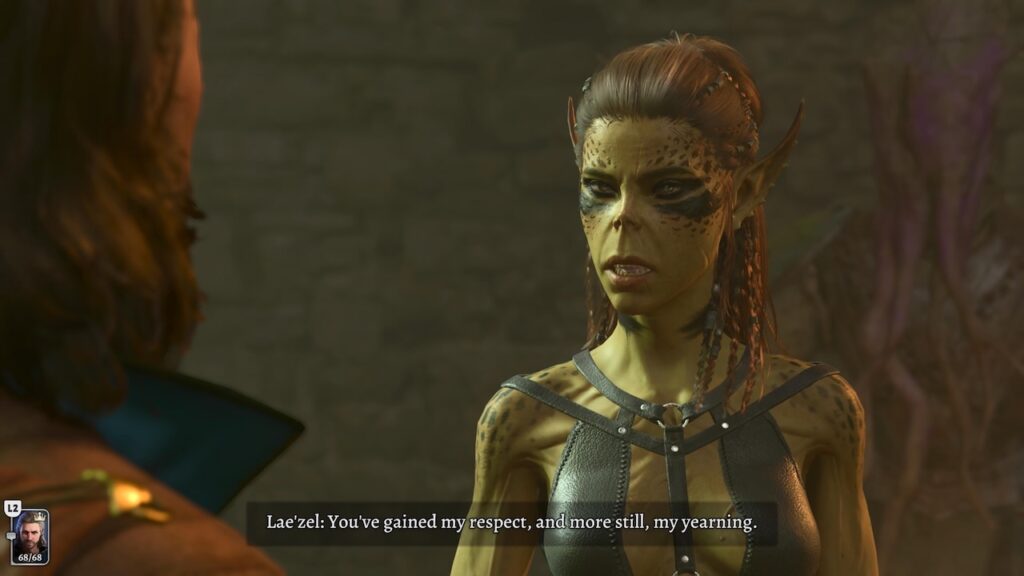
The game presents much of its story through cutscenes. You will see different cutscenes depending on the choices you’ve made. Part of the joy in playing the game is to make a series of choices, then see a cutscene (voiced and motion-captured); this means that the game’s creators anticipated your choices and acknowledge them.
If you skim through YouTube, you’ll see video clips from folks who explore the wide world of the game’s decision space (“What if I romance A, then kill their friend B, then sleep with C, then try to apologize to A”), only to find that the game has a cutscene that covers that sequence of choices.
As an illustration of how expansive the story possibilities are, I recently watched this video in which Devora Wilde, the voice actor for the character of Lae’zel, plays BG3. I didn’t watch the prior 31 episodes in this series, but it appears that Wilde chose a playthrough in which she plays a Tav named Dev’zel who romances Lae’zel.
The link I’ve posted goes to the last 40 minutes of the video. In this section, Wilde’s character experiences an unexpected intense romantic moment with Lae’zel; from my own playthroughs, I know this must have happened after any Lae’zel sex scenes. Wilde is stunned by how romantic the sequence is, and how character-defining it is for Lae’zel. Bear in mind that she herself recorded those lines, but she either had forgotten what she’d said, or never before experienced them in context of the finalized cutscene.
When the story possibilities exceed the experience of their performers, that’s a sign of how well the story, writing, and performances are crafted.
“Barbie dress-up”
I mentioned above how players are shown a nude image of their Tavs during character creation. This can be relevant in one of two ways.
One is how your character is shown during sex scenes. Not all such scenes show the characters with full-frontal nudity. But for those that do, you have some measure of control over your character’s nude appearance.
The other is an optional feature of how your character is displayed the rest of time. The normal display of your character shows them in whatever armor they’re wearing.
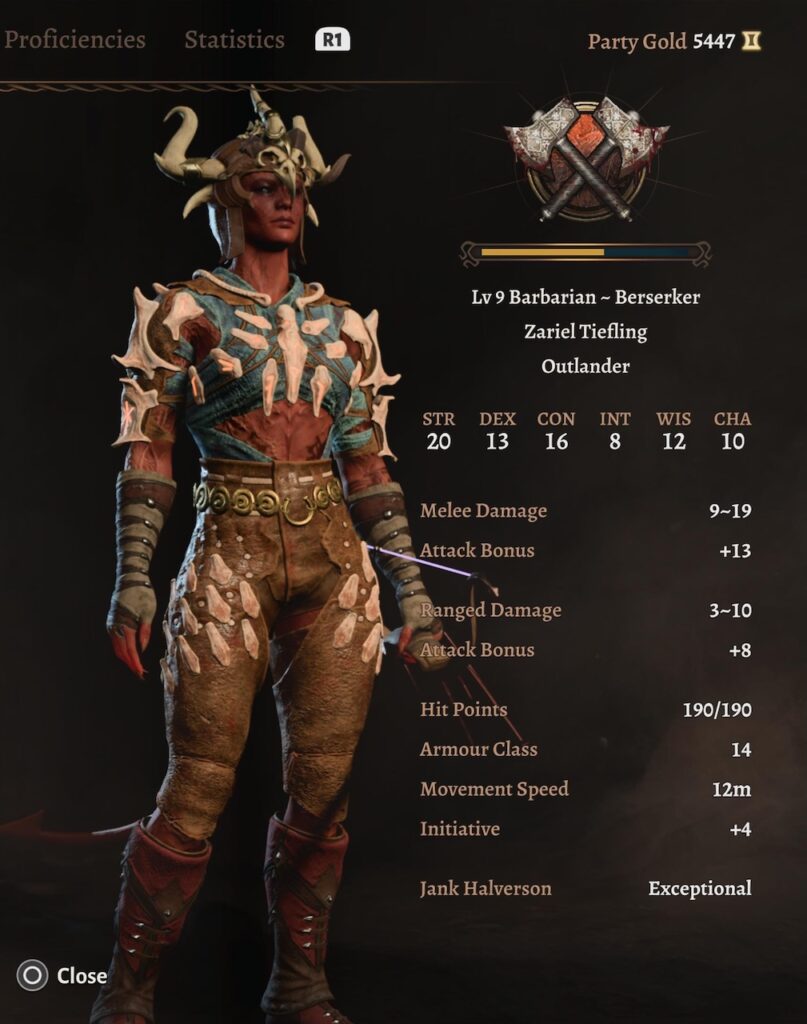
With a click of a button, you can turn off the display of their helmet so you can see their faces.
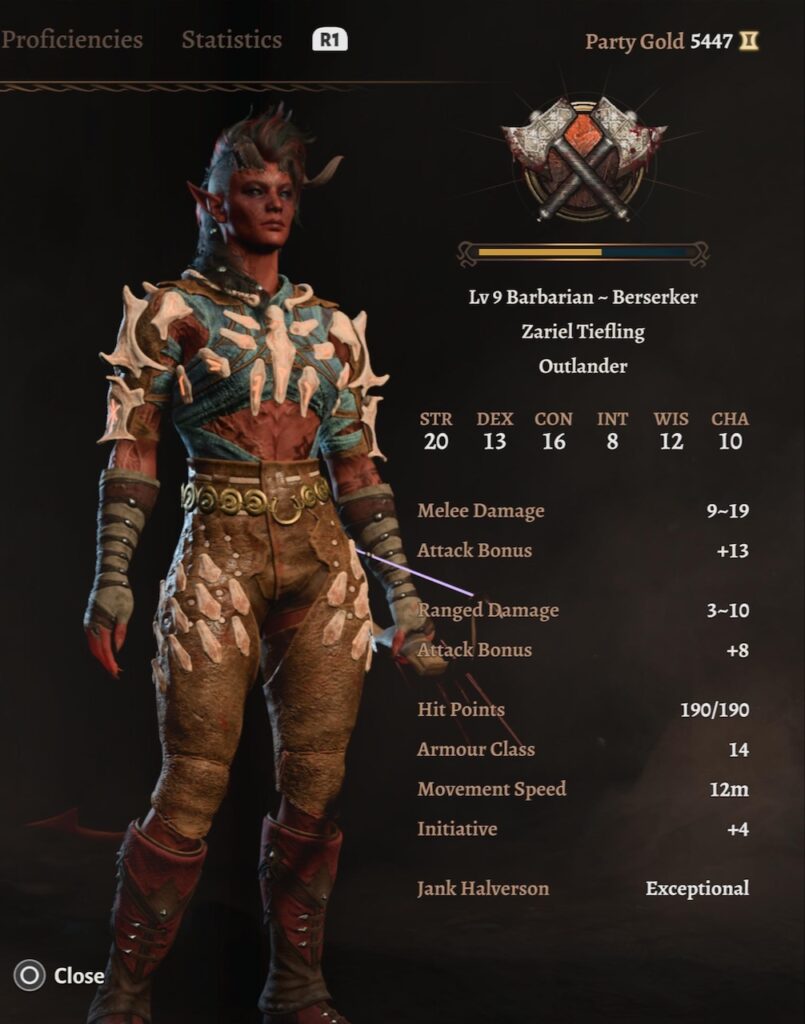
With another click, you can turn off the display of their armor. The character is shown as they’d normally appear “in camp”, in their casual clothing.

You can “unequip” that clothing, so you see the character in their underwear.
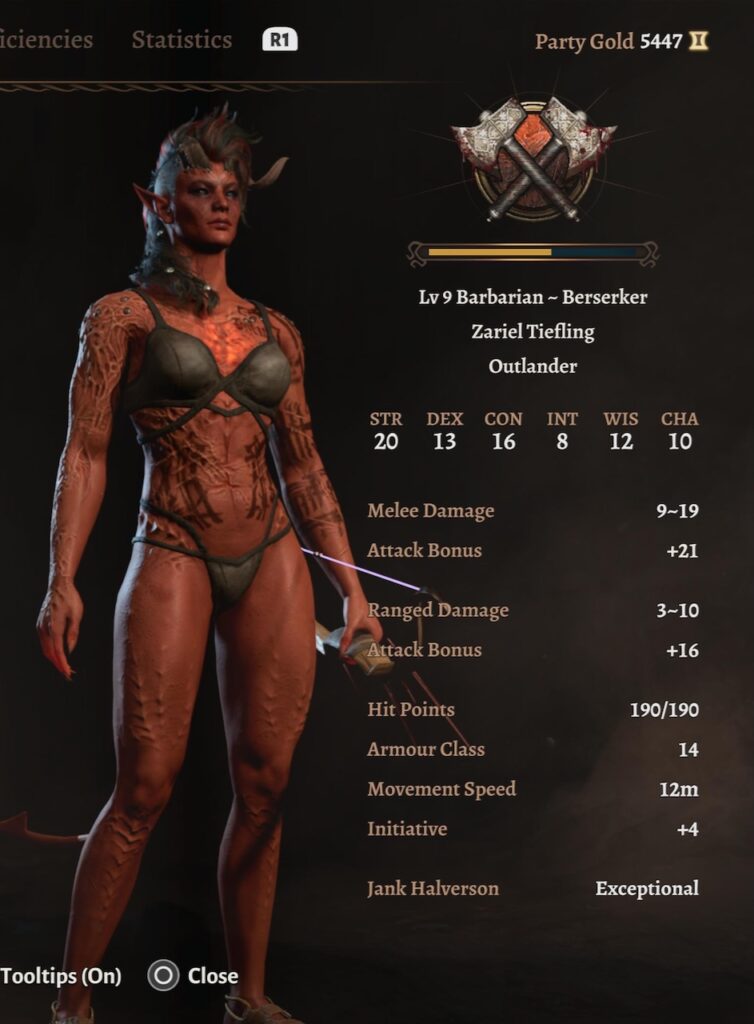
Finally, you can unequip the underwear. Unfortunately, due to a problem with my PS App, I was not able to insert the picture in this blog post.
If you wish, you can adventure with a bunch of nude party members. Their armor and related abilities are still in effect, even though they’re not displayed.
For an extra game challenge, you enable the armor display but not have your characters put any armor or clothing on. This makes the game considerably more difficult. (If you want to try this, give your characters a high DEX (high CON for Barbarians, high WIS for Monks), make liberal use of Mage Armor, and get good shields.)
This may sound like it appeals to the male gamer libido. But I observe that the majority of the YouTube videos featuring the characters wearing skimpy underwear seem to be posted by female gamers. This may be selection bias, in that YouTube wouldn’t permit full nude character videos.
Did I try to adventure with a nude-appearing party? I did… for about five minutes. It was strange. Even though I knew it was just digital imagery, it seemed like I was taking advantage of the characters that I’d grown to know.
Eventually, for my one my playthroughs, I fielded an all-female party in their underwear. It had its amusing moments, including watching a group of bikini-clad women beat a dragon into the ground.
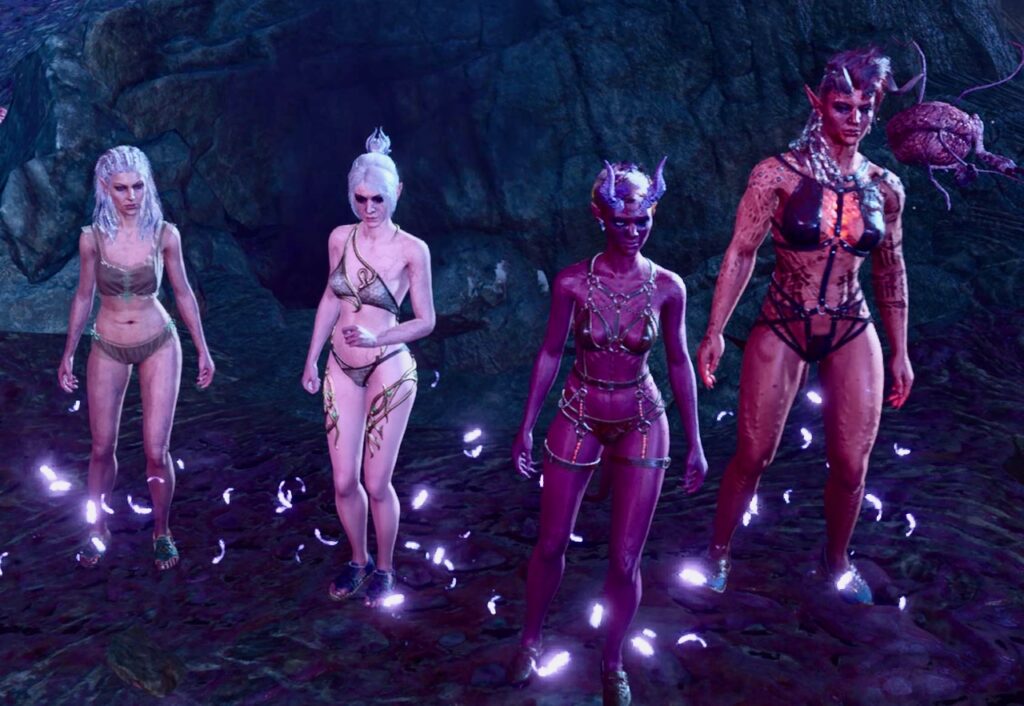
The “Barbie-doll” game display doesn’t end there. You can’t change the look of a given gear item; a Robe of the Weave always has the same shape when it’s displayed.
However, you can purchase dyes from almost every vendor. You can’t change the shape of a garment, but you can change the color.
Not every dye is available from every vendor, and the more exotic dyes are more expensive, harder to find, and available in limited quantities. Some dyes are multi-colored. Different dyes have different effects on items composed of different materials. (Try using a bright-colored dye on Shadowheart’s casual outfit, for example.)
You can also find “casual clothes” scattered throughout the game. Most of them are low-end, but sometimes that look combined with an appropriate dye might look good to you.
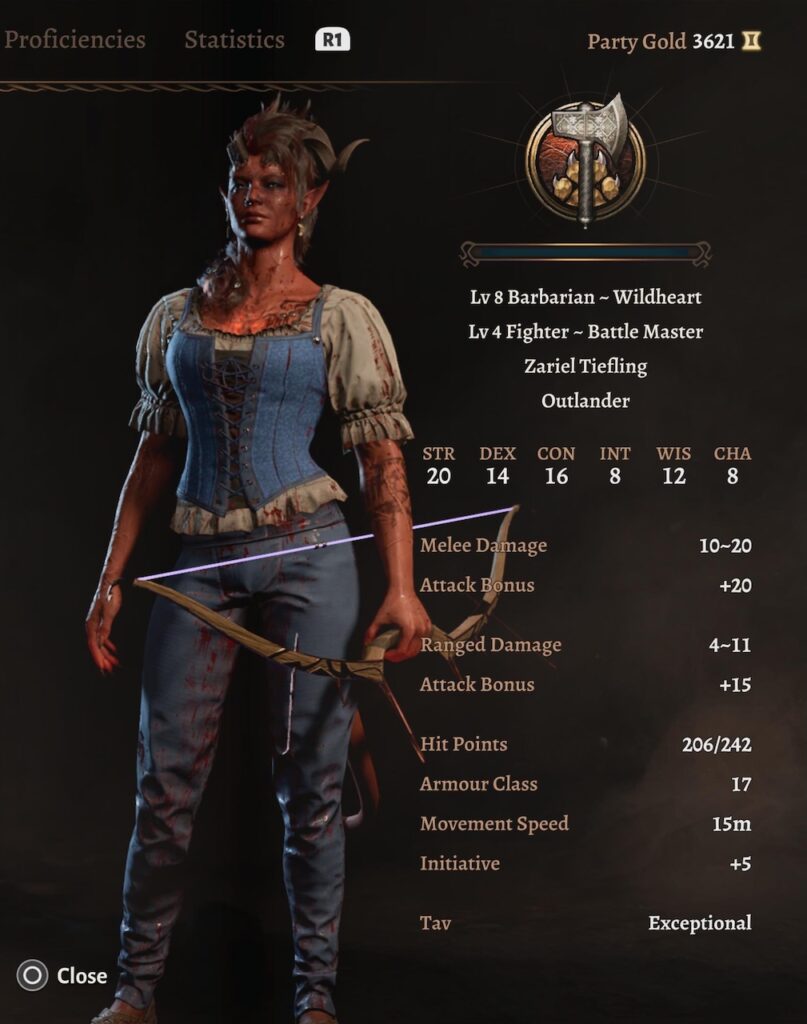
In Act 3, there are vendors who sell the fanciest outfits and underwear.

In other words, you can play “dress up” and “dress down” if you choose.
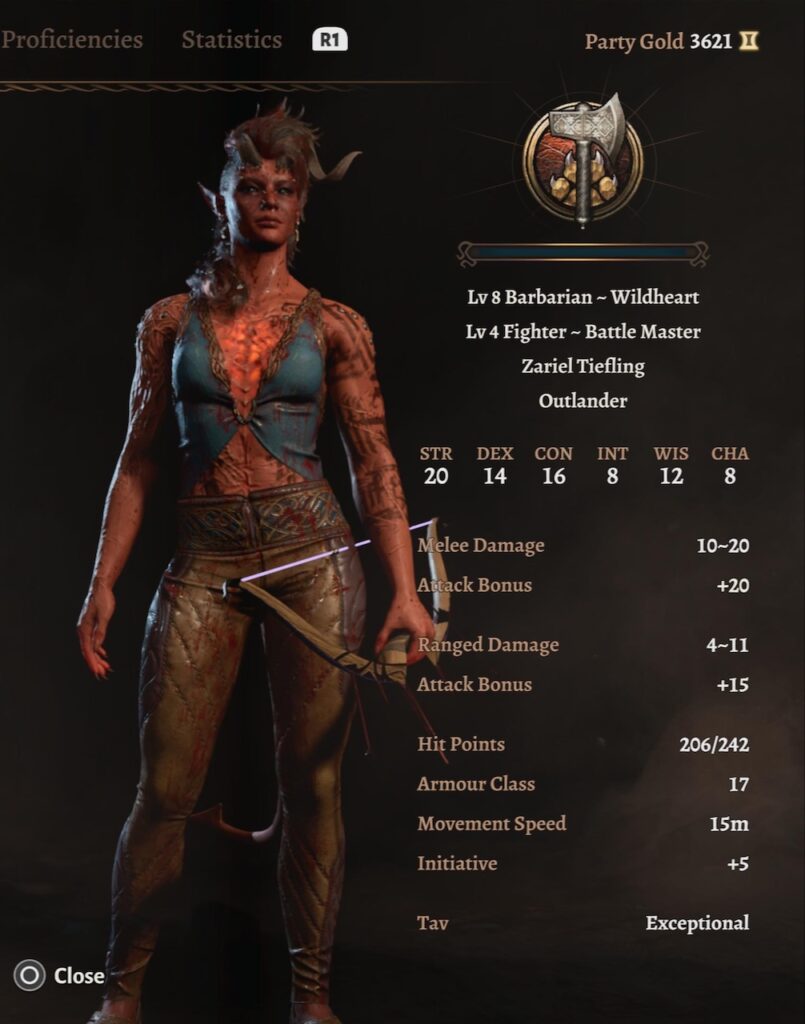
I’m sure that being able to play with your character’s appearance in the same way one can play with a Barbie doll is not the reason for the game’s success. It’s just pleasant that the game permits its players to indulge themselves in fashion design if they so choose.

I’ve occasionally fielded a party in which all their outfits (no matter how casual or skimpy) were colored with the same dye.
It’s all about the choice.
Playthroughs
The rest of this post is a diary of my playthroughs. It’s to give an idea of why the game has an appeal for multiple run-throughs. It’s also a record for me. I may even update this post with subsequent runs.
If you haven’t played the game, you may not want to read the rest of this post. (You may not want to read the rest of this post anyway. I’m not the boss of you!)
While I’ll try to avoid spoilers, there’s at least one spoiler that I cannot avoid.
So: SPOILER ALERT!
Multi-classing
If you’re experienced with BG3, as I discuss my various build choices, you may notice a contradiction: Most of these playthroughs are in Explorer mode, which does not permit multi-classing. I used a standard trick: Change the game’s difficulty level, add the new class to character, then set the difficulty back to Explorer again.
I don’t think this is cheating. I think of it as maximizing my pleasure while playing the game. It’s up to you.
Playthrough 1: Jank Halversen
For my first playthrough, I decided to try a character that I’d created for someone else’s on-line D&D campaign. In that campaign, Jank was the slimiest of stereotypical slimey Bards. In that game, he later acquired a level or two of Warlock. I followed suit in BG3.
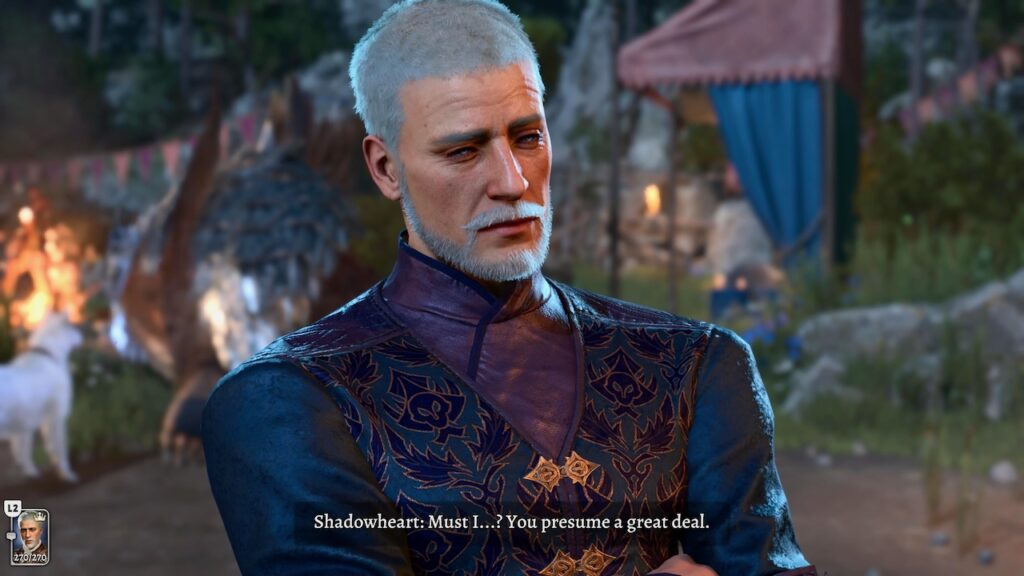
As a character who plumbed the worst of Bardic behavior, I wanted his BG3 incarnation to have a sex scene with all the characters. This is just barely possible (this particular person achieved 11.5 out of 13.5 possible):
However, it really wasn’t possible for a first playthrough, in which I did not know the flow of the game. The first sex scene I got was with Gale. It was extremely well-staged. But I’m not really into man-on-man action, and wanted to shift to someone else. However, every other character started congratulating me on my relationship with Gale, and wouldn’t contemplate interfering with that.
I restored the game from a previous save. In the end, Jank only had a single relationship, with Shadowheart. She’s definitely worthy of a relationship (unlike Jank, perhaps).

This run set my “relationship goals” for future runs: I’d only try to establish a relationship with a single character. Since there are only four female characters who are romancable, that meant I’d be cycling through some of the same experiences in each run.
However, each character has their own style of relationships, some of which are affected by player choices elsewhere in the game. No two relationships will be exactly the same.
Oh, the playthrough itself? As I said before, I play BG3 on Explorer difficulty, the lowest. Also, I played a Bardlock (a mix of Bard and Warlock), which in both D&D and BG3 is one of the most potent class combinations. I didn’t have much trouble completing the game.
I didn’t write down exactly who made up my final party. I know I made use of these guides:
I think I used this for Jank Halversen:
How I built Karlach. It’s my “go-to” build for her in other playthroughs:
Astarion:
Gale:
As I note elsewhere, I’m not good at playing a Wizard. I know I ended with Shadowheart in my final party:
But I also know that I’ve never stuck with a Trickery Cleric build for Shadowheart. I might remedy that in a future playthrough, but Asterion or a Monk character is so good at filling the Rogue role. I probably chose Life or Tempest Domain for Shadowheart, based on this guide:
I used this build for Wyll in this and some of my playthroughs, but he doesn’t seem to wind up in my final party composition. I think it’s because I’m not enamored of his story:
Playthrough 2: Karlach
At the time I write this, I’ve completed six playthroughs of the game so far, and have started a seventh. In each one of the playthroughs, I’ve seen something I didn’t see before.
In my first playthrough, I never found Lae’zel. That meant that I never went into the Mountain Pass; I didn’t see a reason to go there.
This is a big area, not just some hidden room that I hadn’t opened before. I was amazed. All this brand-new content, all from finding Lae’zel by zigging instead of zagging as I explored the world!
As another example of new content, it was during my first playthrough that I learned that (ALERT! LAST CHANCE TO AVOID SPOILERS!) one of the antagonist characters that you meet early in the game, Minthara, can be romanced.
There are two approaches experiencing that relationship.
-
Near the start of the game, you learn of a conflict between two forces. Let’s call them the “Karlach” faction and the “Minthara” faction. In a normal playthrough, you’ll typically choose one side or the other. (You can skip the conflict entirely if you choose, but the outcome is the same as siding with the “Minthara” faction.)
Minthara is in (be careful; this will be on the test) the “Minthara” faction. I identify the opposing faction as the “Karlach” faction because, if you fully assist the “Minthara” faction, Karlach will leave your party permanently.
If you choose the “Minthara” faction, then after you experience the immediate consequences, and if your attitude pleases Minthara, she will grant you the most explicit sex scene in the game.
- It’s not immediately obvious, but you can choose the “Karlach” faction, but control the outcome so that Minthara is not killed when you defeat her faction.
Either way, if Minthara survives the conflict between those two factions, you’ll have a chance to meet her later. You can choose to add her to your adventuring group. (For those up on their D&D lore, by default Minthara is a Lolth-sworn Paladin, which is quite a combination!)
I became interested in pursuing a romance with Minthara because of an idle comment made by Samantha Béart: there was a special interaction between Karlach and Minthara. They didn’t specify what happens or in what context this occurs. I wondered if this was related to a romance scenario.
I chose to play Karlach in my second playthrough specifically to pursue the Minthara romance. It also helped that I learned during my first playthrough that Karlach is a serious kick-butt character who’s fun to play.

I therefore played “Evil Karlach”, making choices that Karlach as a companion would never support. I chose the “Minthara” faction. I got that sex scene. My jaw dropped.
However, afterwards I didn’t like how the story began to evolve. I decided that I’d seen the scene (and I have a game save to see it again if I choose), but I’d go back to an earlier save and choose the “Karlach” faction.
I was careful that Minthara was not killed as a result of that choice, met her later in the game, added her to my party, and started a romance with her.
From a storytelling standpoint, once you add Minthara to your group, there’s no more to her story arc. There are no sex scenes, nor any “additional romance” scenes like those present for Lae’zel or Karlach relationships.
The general opinion of the player community is that Larian never intended for Minthara relationships to be as popular as they eventually became. It may also be that, in such a deep and complex game, they simply did not have the resources to fully support a continued story arc with Minthara’s character.
However, though Minthara no longer has any scenes specifically dedicated to her, she has a wide range of commentary on the current game situation. She is fierce. She is direct. And she will support any choice you make in your self-interest. Want to murder everyone in a building to get their loot? Minthara will point out that there more buildings nearby to raid.

As I composed this essay, I learned that my characters have romanced Minthara more than any other. I didn’t plan it this way. But she is such a delight to have as a romantic partner.
Yes, she’ll try to poison you. That’s how drow express affection. Also it’s how they express hatred. And how they advance in rank. And how they celebrate birthdays.
To love them, you have to accept them as they are.
Aside from gushing about Minthara…
In this video of Samantha Béart playing Karlach in BG3, I learned something that would affect all my remaining playthroughs: If you’re playing an Origin (or Dark Urge) character, the first thing you want to do after you wake up on the beach is take a Long Rest by yourself. There’s no game-system reason to do this. However, your character will have their own custom monologue that you won’t necessarily see later.
Karlach’s monologue is delightful. I leave it for you to discover.
I should add: While the Minthara explicit sex scene is still within the game, Larian patched the game since my second playthrough. It’s no longer possible for Karlach to have that scene with Minthara, because she’d burn Minthara to a crisp.
Playthrough 3: “Tav”
You were fooled, weren’t you? No, my third playthrough wasn’t with a Tav. It was with The Dark Urge. I changed the character’s name, appearance, and class from the defaults, just to fool everyone.
To make it clear: There was no one to be fooled. This was just a little bit of nonsense on my part. The game doesn’t do anything special in response to your character’s name. Based on what I see on YouTube, I’m far from the only person who’s given their Dark Urge (aka durge) character the name “Tav”.
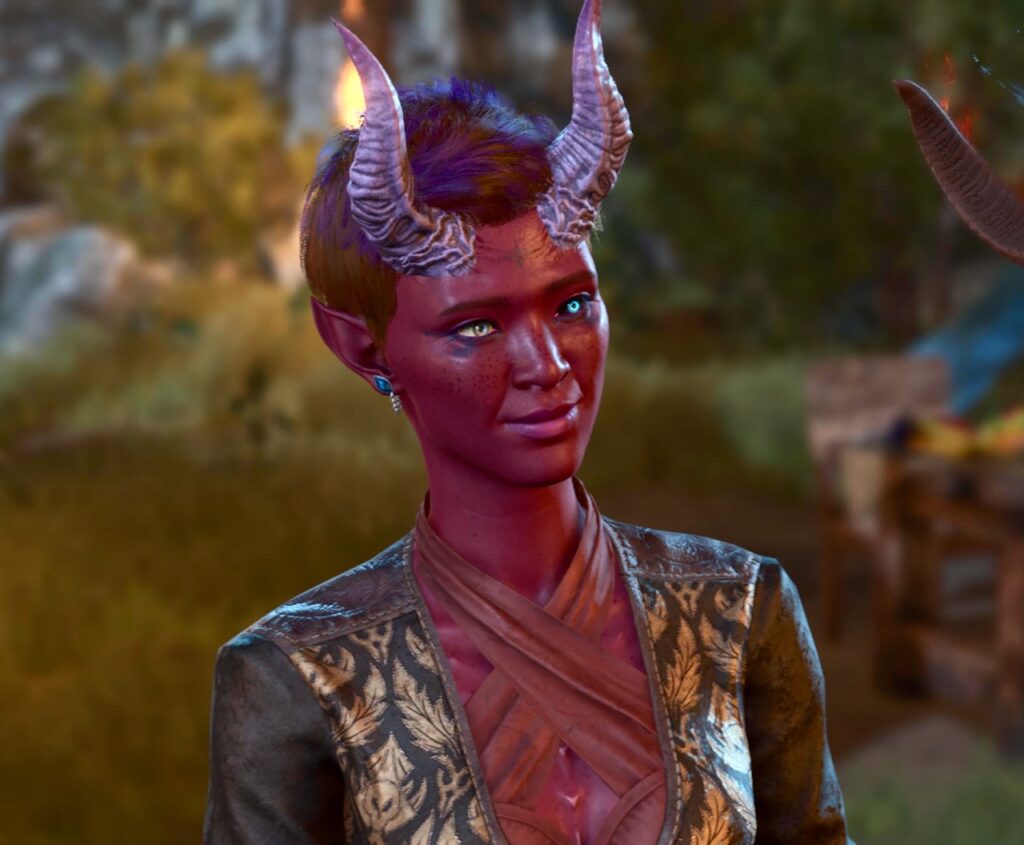
I based the design (in both appearance and game statistics) on this video about creating a “succubus” character. It seemed appropriate for a Dark Urge.
In terms of game play, I was still not facile with the mind-control abilities described in the video. In the end, I played “Tav” as a Bardlock like Jank Halversen. I may return to the succubus concept some day, now that I know how to make spells like Hold Person work.
However, given that Tav is a succubus, the image I have of the “Swedish Bikini Team” above makes story sense: She got all all the other characters to embrace their sensual freedom. If you ask “Why is Jaheira on the team and not Lae’zel?” it’s because there was a catfight, and Tav didn’t encourage a compromise.
When you play the Dark Urge, you have an overall choice: You can embrace the darkness within, or you can struggle against it. For this playthrough, I chose to fight my way towards the light.
The main reason why I made that choice is that I wanted to romance Karlach.
What? Hadn’t I just played Karlach?
The romance and sex scenes in the game are not mirrored between the characters. If you play Karlach and romance character X, you’ll see the scenes associated with character X. I wanted to experience the scenes where Karlach was the object of affection.
Beyond that, unlike Minthara, Karlach is a fully fleshed-out character. Her back story is sad and tragic, yet she still maintains an optimistic attitude. She’s worthy of love, and eager to be loved.
She’s horny as hell, and that’s a pun based on her being a one-horned Tiefling who’s escaped from Avernus. Her story (which you can see in the introductions during character creation) includes that she hasn’t been able to touch another living soul for ten years. She’s starved for sex, a hug, a kiss.
You can choose to cure her condition. This doesn’t automatically mean you’ll be in a relationship with her, but it’s a good first step. Otherwise she won’t be able to touch you, and there’ll be a limit to the sex/romance scenes.
Karlach has a strong sense of right and wrong. Unlike Minthara, she won’t approve of you doing bad deeds.
She also curses like a soldier.
I don’t want to spoil too much, but if you choose the path of redemption for The Dark Urge, and if you’re in a relationship with Karlach, she’ll support you all the way. (It might be that other characters would as well; I don’t know yet.)

As I said above, I would not recommend playing The Dark Urge in your first playthrough. However, I do suggest playing them eventually. There were some elements of the game’s story (notes written in books and such) that didn’t make sense until I had the full context revealed in a Dark Urge playthrough.
This is another example of the skill of the game’s writers and creators.
Playthrough 4: Lae’zel

As I went through my first three playthroughs, I made increasing use of on-line build guides, as I discuss above.
Part of the reason is that there are classes that I have difficulty playing. I’ve never been able to get a Druid or Paladin to make a meaningful contribution to a party. I hope to remedy that.
This was a bit irritating for me. I mentioned above that Minthara is a Lolth-sworn Paladin, but I couldn’t make that work. I’ve always had to re-spec her into something else.
For my Lae’zel playthrough, I set up both story goals and character development goals. Playing Minthara as Minthara was one of them. I failed.
I started the playthrough with the intent of setting up Wyll as a Sorlock. The title of this video is over-blown (as are most videos of this sort), but this one is extremely effective:
When I couldn’t make Paladin Minthara work, I respecced her as a Sorlock and she replaced Wyll in the party. I still wanted to hear the Minthara/Karlach banter that Béart hinted at. (A few playthroughs later, and I still haven’t heard it.
My game goal for Lae’zel was to see how powerful an Open-Hand Monk can be. The answer turned out to be: enemies simply evaporated under the power of her blows.
Some BG3 multi-player groups ban “OH Monks” from their playthroughs because they dominate the game.
My story goal for Lae’zel: In the game, Lae’zel faces a choice of loyalties. In the previous two playthroughs, I simply skipped the choice and went the easy route. For this playthrough, I decided to make the other choice.
I had thought this other choice was an “Evil Playthrough” choice. No, it wasn’t. Again, the game opened a new aspect of the story that I had not known existed.
Once again, I found myself with Minthara as a romantic companion. I don’t remember if that was because such a relationship suited Lae’zel’s personality, or because Minthara’s voice is just so seductive.

Playthrough 5: Shadowheart

In this playthrough, I slipped up on the introduction between Wyll and Karlach. Shadowheart was compelled to send Wyll to that land from which Withers cannot return him. This is the kind of thing a Cleric of Shar might do, after all.
This is the first playthrough for which I kept written notes for the characters.
-
Shadowheart – Start as a Light Cleric:
Then she switches after she affirms her basic beliefs, to become a Dark Justiciar.
-
Wyll – A Mortal Reminder Warlock:
This didn’t seem to work well. Then I switched him to a Punch Drunk fighter. This build really shined!
- Astarion – A typical build choice for Astarion is between a ranged build and a melee build. I chose a melee build for this playthrough.
-
Lae’zel – Barbarian/Monk/Rogue:
This only kinda worked. Then I replaced Lae’zel with:
-
Minthara – Barbarian Thrower.
This build is amazing. It’s another build that is often banned in multiplayer BG3 runs because it dominates the game.
It’s most effective when either being played by a Dwarf, or a character shapeshifted into Dwarf.

Slumming around in a fancy place. Minthara (middle of the sofa) has a weapon that’s most effectve in the hands of a Dwarf, so she’s Shapeshifted. Astarion has a ring that improves his skills when Shapeshifted, so he looks like a female Tiefling. Wyll gallantly remains standing while the women take a load off their feet.
In this run, I decided to give in to Wyll’s incessant yammering and fulfill the initial request he makes in every playthrough in which you encounter him. I never forgave him… at least for this fifth playthrough.
True be told, I also wanted to see how the game’s story adjusted in response for doing what Wyll asked. I was surprised at some of the consequences.
I also made another choice that made life difficult: I chose to attack the Archduke of Baldur’s Gate during his coronation. I succeeded, after a two-hour-long battle, with my party alive but none having more than 10 hit points.
If I hadn’t been playing in Explorer mode, I never would have made it.
Again, the game’s story adapted to this victory in ways I did not expect.
Once more, Minthara found herself in a relationship with my main character. This fits nicely with Shadowheart’s personality.
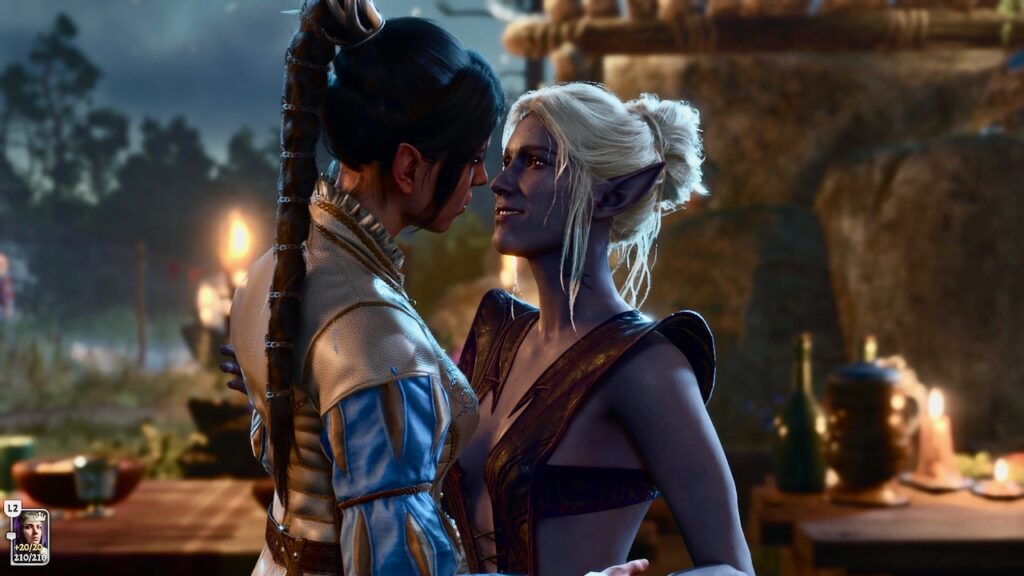
A couple of side notes:
-
Another SPOILER ALERT, if my previous one was not sufficient: You can recruit Minsc as a playable character.
This was the first playthrough in which I made an effort to add Minsc to my party through to the end of the game. His humorous remarks made up for the fact that I didn’t really make his build work.
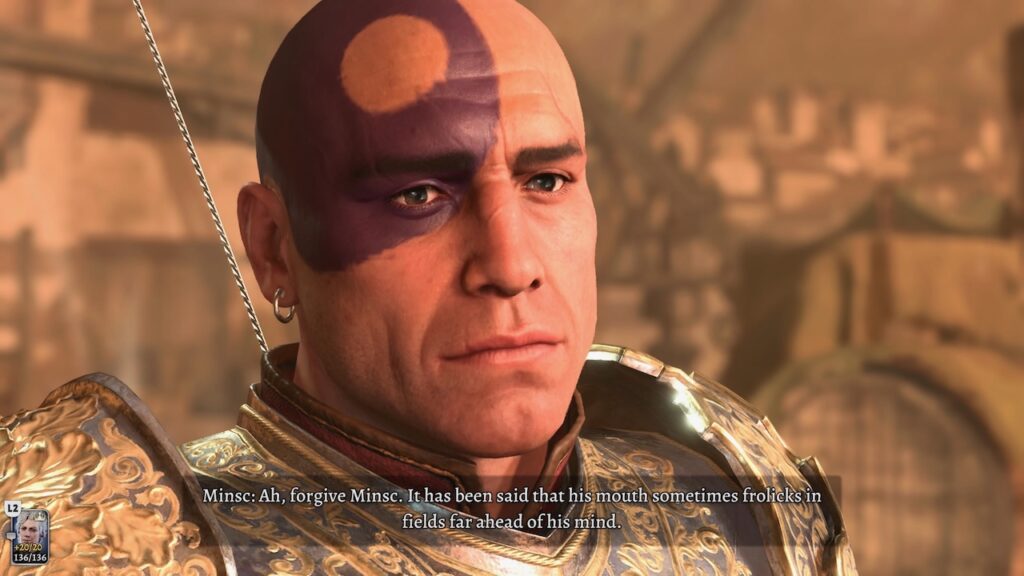
-
This was the first playthrough in which I became fully aware of the story arc of Barcus Wroot. He starts out as a humorous, fumbling character. Later, you become aware of how strongly he feels about Wulbren Bongle. As the story progresses, and depending on the choices you make, you can see Barcus finally turn a corner in emotional maturity.
In my four previous playthroughs, I had no idea his story existed. Again, bravo to the Larian creative team!
Playthrough 6: Astarion
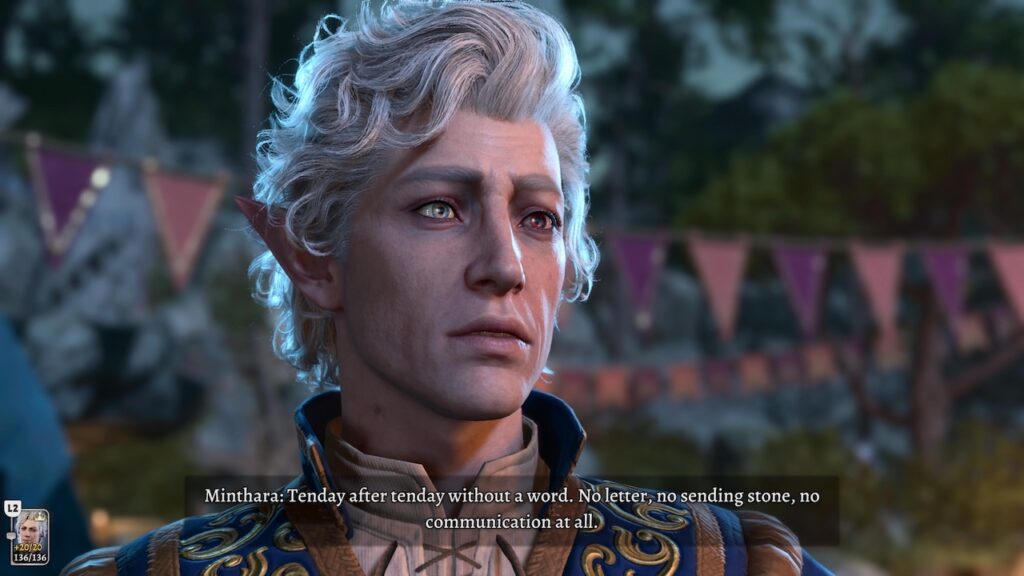
After five playthroughs on Explorer mode, with experience of advanced builds under my belt, I decided to try the game in the next-highest difficulty setting: Balanced.
The game handed my butt to me.
If you’re an experienced gamer, at this point you’re holding me in contempt. Hey, it’s not my fault you chose to read this far!
I got through it by… not to put a fine point on it… cheating.
I previously mentioned hirelings. What I did was to hire three of them, and did not include them in my regular party. Instead, I tuned their abilities to provide the main party characters with long-term buffs: Mage Armor, Longstrider, Goodberries, Warding Bond, Protection from Poison, Freedom of Movement, Heroes’ Feast. Since the hirelings supplied the buffs, this freed up spell slots for the main party.

Another way in which I cheated was to take advantage of a flaw in the game that will probably be patched soon. There are two weapons in the game, Flame Blade and Shadow Blade, which are intended to only be temporary. However, if a hireling is holding the temporary blades when they are dismissed to the Fugue Plane, and then re-hired, the blades they were holding become permanent.
For me, I found this was only “over-powered” in the mid-game. By the time I reached the end-game (despite what the game math implied), the more “conventional” magic items gave me more reliable performance.
In this runthrough, I was determined to have both Jahiera and Minsc in my final party. These characters are from earlier Baldur’s Gate games. I’ve never played those games, but I thought they might have shared dialog and special insights from being adventurers in the “old days”.
Once again, the game’s story did not disappoint. Bravo and brava to Larian Studios!
For this playthrough, I used the following builds. Most of them shined by Act 3. At the end of the game, I barely knew I wasn’t on Explorer mode.
- Astarion – Dual Archfey Warlock.
-
Karlach – Cold Barbarian
I’ll add: Be careful with Spud the King’s build videos. I find them to be very hit-or-miss. This one worked well, however.
After relationship problems with Karlach (described below), I replaced her with Minthara, transferring all the items and speccing her in the same way.
-
Gale – Storm Sorcerer
This worked well, but more from Gale being a sorcerer than by following the strategy in that guide.
The problem is that I can’t get a handle on the strategy to place water on the ground in the midst of the game’s “action economy”. For builds based on lightning and cold (see the Cold Barbarian build above), this is important; ice freezes water (enemies fall down) and lightning electrifies water (enemies take damage and have de-buffs). But I can’t figure out to place water (or other obstacles, like Darkness or Spike Growth) in such a way that enemies just don’t walk out of it the following turn.
I’ll note that, in general, I have difficulty working with Gale as a full Wizard. To me, a Wizard’s spell-slot limits make them seem weak compared to other classes, especially with respect to Long vs. Short Rests.
- Shadowheart – A full Light Cleric build, as in the beginning of the Shadowheart playthrough.
Later in the game, I replaced the last two with:
-
Minsc – Cold Archer
Another Spud the King build that happened to actually work.
-
Jahiera – Druid of the Land
As I said above, I’ve never quite been able to get a Druid to work. I’ve tried Circle of the Land (lots of area effects), Circle of the Moon (turn into various animals), and Circle of the Spores (create lots of minions).
This playthrough was no exception. Jahiera didn’t do much damage, and the enemies laughed at her attempts at area control. The other party members basically carried her through to the end of the game.
The relationship saga for this run was marred.
It was my original intent to romance Karlach. While we worked out our physical issues, she gave me a “hall pass” to sleep with other characters.
Lae’zel then put the moves on me. I acceded, intending to end that connection once Karlach was fully available.
Then Lae’zel escalated the relationship. I accepted it. I thought I could still end things with her, without consequence, to return to Karlach.
Instead, Karlach chewed me out for leading Lae’zel on. (Her words were “You can’t treat us like toys.” C’mon, Larian, that’s what they are!) So I ended it with Lae’zel.
I returned to Karlach and… nothing. There were no dialog options about what happened. There was no way to continue the aborted relationship with her.
According to the game’s status indicators, Karlach’s approval of me was Exceptional. That’s normally reserved for a character who’s in a full relationship with you.
A couple of dialogs with other characters suggested that I was still in a relationship with Karlach. A pity she didn’t think so.
In case it’s not clear: This was a game bug.
Finally, after I recruited Minthara into the party, she made the initial move to start a relationship.
I yielded to the inevitable. Once again, Minthara was my main relationship for the rest of the playthrough.
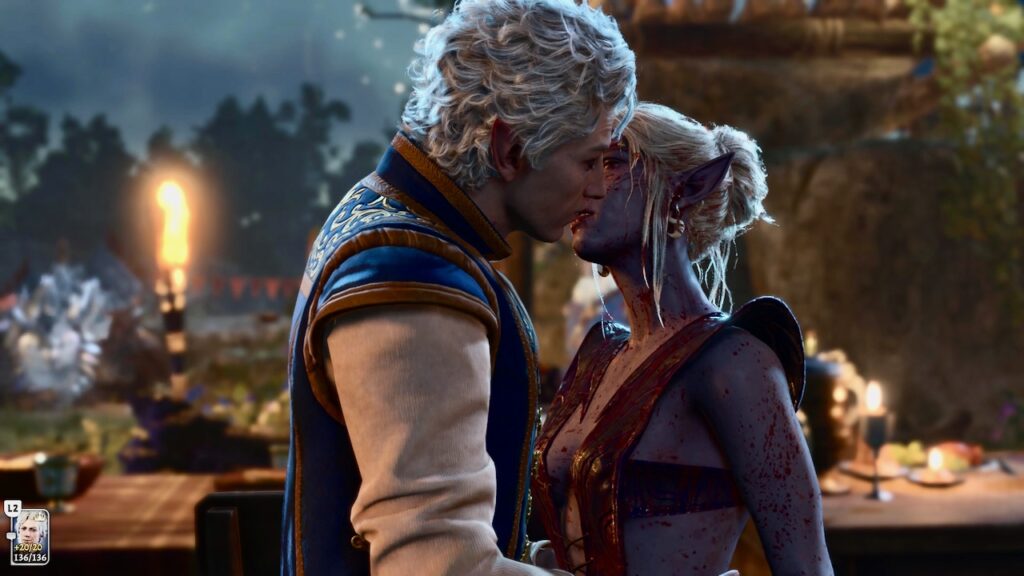
Another breakthrough during this playthrough is that I finally figured out how to reliably transfer screenshots from my PS5 to my Mac:

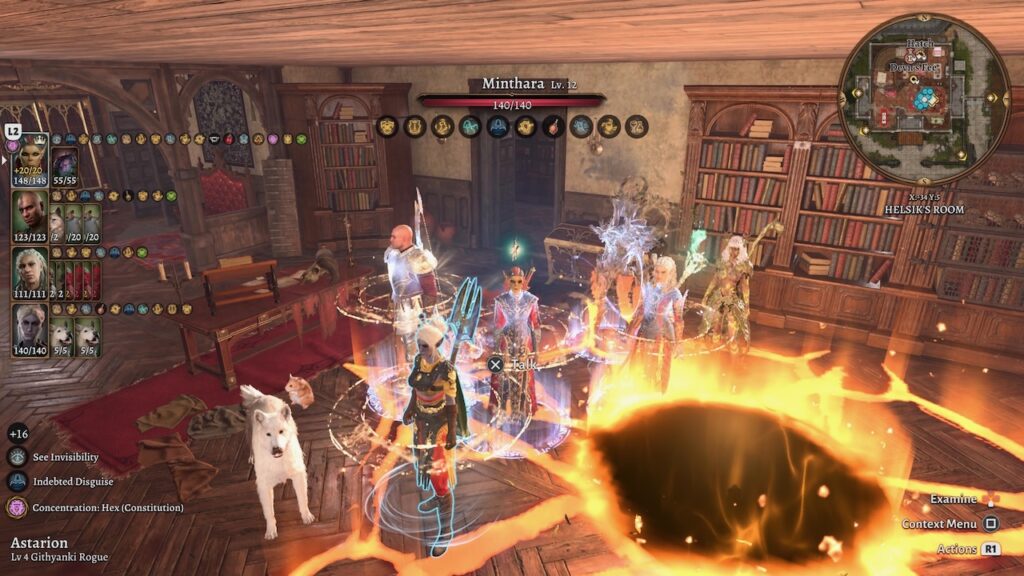
The majority of the in-game photos you see in this essay come from game saves of earlier playthroughs that I restored solely to take these pictures.
It’s in this playthrough that I finally chose to unlock the sequence you can see in the ads for BG3: Astarion got to have sex with a bear. It gave him the warm fuzzies.
Playthrough 7: Gale
Back to Explorer difficulty!

As I type this, I’m roughly 1/6th of the way through my seventh playthrough. I’m trying to make Gale work as a Wizard. I’m following this build:
Already I’ve deviated from the build given in the video. I like my spell-casters to dual-wield both staves and hand crossbows. The easiest way to do this is to take one level of Fighter before going into Wizard.
As I was preparing this post, I became aware of how a relationship with Minthara has dominated my playthroughs, and that none of them had a permanent relationship with Lae’zel. Time to change that.
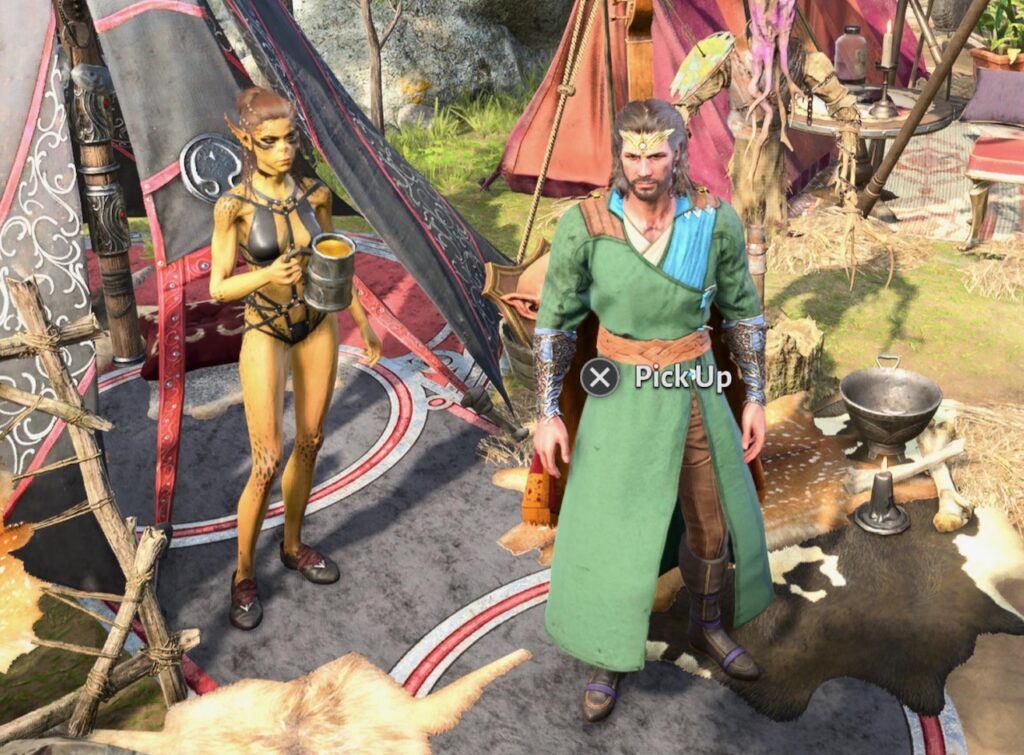
Since I took that picture, Lae’zel has entered into a physical relationship with Gale. We’ll see where it goes from here. He’d better be careful, since she’s a Shadow Assassin:
My build goals are repeats from previous playthroughs:
-
Shadowheart as a Light Cleric again. In none of the my previous playthroughs did she reach the end of the game with this build. I hope to see her all the way through this time.
Or maybe not. If I can get Minthara to be effective as a Lolth-sworn Paladin, I may use her instead.
- Karlach as a Barbarian Thrower. It will be a while before I have to decide whether she’ll shapeshift into a Dwarf, as Minthara did in my fifth playthrough.
I’ve already set “Operation Rescue Minthara” into motion, but no relationships this time. Jaheira can sit on the sidelines, as can Minsc. As for Wyll…
Future playthroughs
My next playthrough, if there is one, will be number eight. I’ll play Wyll, to complete my “sweep” of the Origin characters.
After that, I’ll probably return to The Dark Urge, but fully give in to the impulse to murder. I wonder if I’ll be reduced to hirelings before the end of the adventure; the Origin characters might have left by then. (“Yeah, that’s right… they ‘left’. Don’t pay attention to the blood on the ground.”)
And then…
I don’t know. I’ll tire of the game eventually. I might tire of it tomorrow. Or I might still be playing it months from now.
Overall, Baldur’s Gate 3 has been an excellent entertainment value for the money.
Kudos to Larian Studios!
By the light of Selûne! It turns out that there’s a way to entirely cure Karlach!
Once again, Larian has impressed me with the hidden depth of this game.
This falls under the category of SUPER SPOILEROUS MAXIMUS. Don’t click on this YouTube link unless you’re very familiar with the game, and you really care about the fate of Karlach.
One more time: This is a mega-spoiler. If you click on the link, you will be tempted to play the entire game again just to implement this.
You’ve been warned.
How to cure Karlach
Pingback: Baldur’s Gate 3 – Playthrough 7 – Gale – The Argothald Journal
Pingback: Baldur’s Gate 3 – Playthrough 8 – Wyll – The Argothald Journal
Pingback: Baldur’s Gate 3 – Playthrough 8 – Those who made it – The Argothald Journal
Pingback: Baldur’s Gate 3 – Playthrough 9 – Laurelin – The Argothald Journal
Pingback: Baldur’s Gate 3 – Playthrough 10 – Easing up – The Argothald Journal
Pingback: Baldur’s Gate 3 – Playthrough 11 – Romancing a Wizard – The Argothald Journal
Pingback: Baldur’s Gate 3 – Playthrough 11 – A Hireling’s Destiny – The Argothald Journal
Pingback: Baldur’s Gate 3 – Playthrough 11 – Wrapping it up – The Argothald Journal
Pingback: Using BG3 to understand Mac OS face recognition – The Argothald Journal
Pingback: Divinity Original Sin II – The Argothald Journal
Pingback: 59! – The Argothald Journal
Pingback: 67!! – The Argothald Journal
Pingback: Baldur’s Gate 3 – Playthrough 12 – Banter – The Argothald Journal
Pingback: Baldur’s Gate 3 – Playthrough 12 – Relationships – The Argothald Journal
Pingback: Baldur’s Gate 3 – Playthrough 12 – More Relationships – The Argothald Journal
Pingback: Baldur’s Gate 3 – Playthrough 12 – Mods – Party of 14 – The Argothald Journal
Pingback: Baldur’s Gate 3 – Playthrough 12 – Bits and Pieces and Nudity – The Argothald Journal
Pingback: Baldur’s Gate 3 – Playthrough 12 – Wrapping it up – The Argothald Journal
Pingback: Baldur’s Gate 3 – Playthrough 13 – Wicked – Spells – The Argothald Journal
Pingback: Baldur’s Gate 3 – Playthrough 13 – Wicked – Evil – The Argothald Journal
Pingback: BG3 – Photo mode – The Argothald Journal
Pingback: Baldur’s Gate 3 – Playthrough 1/14 – Fey and Bellandria – The Argothald Journal
Pingback: Baldur’s Gate 3 – Playthrough 1/14 – Characters – The Argothald Journal
Pingback: Baldur’s Gate 3 – Playthrough 1/14 – Problems and Plans – The Argothald Journal
Pingback: Baldur’s Gate 3 – Playthrough 1/14 – Approvals and Interruptions – The Argothald Journal
Pingback: Baldur’s Gate 3 – Playthrough 2/14.5 – Raelia and Tavelle – The Argothald Journal
Pingback: Preserving BG3 game saves made on PS5 – The Argothald Journal
Pingback: BG3 playthrough log – The Argothald Journal
Pingback: Baldur’s Gate 3 – Playthrough 8’/2.5 – Druid Angela and Mor’lith – The Argothald Journal
Pingback: BG3 – You too can play Arctic Druid Angela – The Argothald Journal
Pingback: BG3 – You can be Arctic Druid Angela too Two – The Argothald Journal
Pingback: Baldur’s Gate 3 – Playthrough 8’/2.5 – Renewal – The Argothald Journal
Pingback: Baldur’s Gate 3 – Playthrough 3’ – Tav and Trophies – The Argothald Journal
Pingback: My BG3 and D&D rules explanations – The Argothald Journal